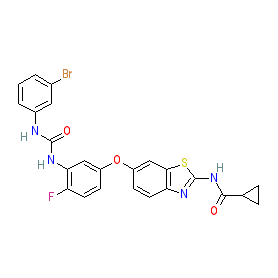GtoPdb is requesting financial support from commercial users. Please see our sustainability page for more information.
|
Compound class:
Synthetic organic
Comment: Compound 42 is reported as a selective inhibitor of receptor-interacting protein kinase 3 (RIPK3), that exhibits potent antinecroptotic activity in vitro, and significant anti-inflammatory action in vivo [1]. Structurally it is a derivative of TAK-632.
Ligand Activity Visualisation ChartsThese are box plot that provide a unique visualisation, summarising all the activity data for a ligand taken from ChEMBL and GtoPdb across multiple targets and species. Click on a plot to see the median, interquartile range, low and high data points. A value of zero indicates that no data are available. A separate chart is created for each target, and where possible the algorithm tries to merge ChEMBL and GtoPdb targets by matching them on name and UniProt accession, for each available species. However, please note that inconsistency in naming of targets may lead to data for the same target being reported across multiple charts. ✖ |
|
|||||||||||||||||||||||||||||||||||
| Bioactivity Comments |
| Compound 42 exhibits improved selectivity for RIPK3 over RIPK1 compared to its predecessor TAK-632 [1]. In an in vitro kinase selectivity screen (KINOMEscan® assay) compound 42 targeted six kinases in addition to RIPK3: BRAF (and BRAFV600E), VEGFR2, SRC, PDGFRA and PDGFRB. However, none of these off-targets are involved in the necroptotic signalling pathway, and therefore cannot be responsible for 42s antinecroptotic activity. |
| Selectivity at enzymes | |||||||||||||||||||||||||||||||||||||||||||||||||||||||
| Key to terms and symbols | Click column headers to sort | ||||||||||||||||||||||||||||||||||||||||||||||||||||||
|
|||||||||||||||||||||||||||||||||||||||||||||||||||||||









